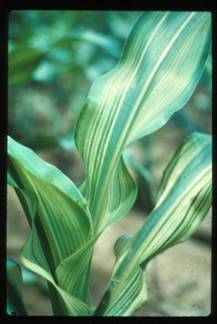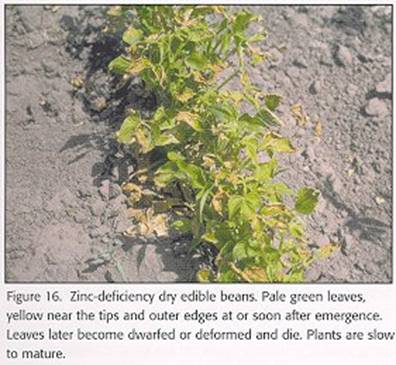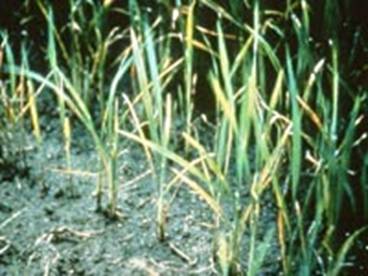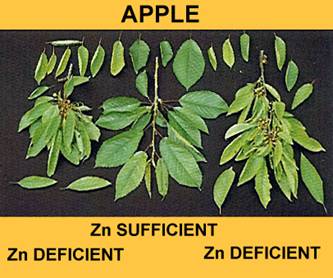Zinc (Zn++)
Functions
Zinc is essential for many plant functions. Some of them are
- Production of Auxins, an essential growth hormone.
- It activates enzymes in protein synthesis, plus is involved in the regulation and consumption of sugars
- It is necessary for starch formation and proper root development.
- Zinc influences the rate of seed and stalk maturation.
- It is necessary for the formation of chlorophyll and carbohydrates.
- The presence of adequate amounts in the tissue enables the plant to withstand lower air temperatures.
Factors Affecting Zn Availability
- Soil pH: Zn availability often decreases as pH increases, however this effect is not universal. This effect can be temporarily overcome by the practice of band applications of acid-type fertilizers.
- Zn:P Balance: High levels of soil P are commonly responsible for Zn deficiencies.
- Organic Matter: Organic matter is a source of Zn, and the organic compounds in O.M. can chelate inorganic sources of Zn and increase their availability.
- Nitrogen Stress: Low N availability decreases the vigor of plants to an extent that it may fail to take up adequate amounts of many other nutrients. Zinc uptake can be affected in this way.
- Soil Saturation: While Zn does not undergo the valence changes that Mn does in saturated soils, research has shown that rice cannot take up Zn as effectively under flooded conditions. The causes of this condition appear to be applicable to other crops in one degree or another.
- Zn:Cu Balance: Plant roots appear to absorb Zn and Cu by the same mechanism. This causes interference in the uptake of one when the other is in excess in the root zone.
- Zn:Mn Balance: Research results have indicated evidence of an incidence of interactions between Zn and Mn. Some results indicate an antagonistic relationship, while others indicate a sympathetic relationship. Certain work indicates that specific cultivars within species may have a stronger reaction to soil Zn:Mn balances.
- Zn:Mg Balance: It has been reported that additions of Mg can increase the uptake of Zinc.
- Zn:As Balance: High levels of arsenic in the soil, as often found in old orchard soils, can seriously inhibit both Phosphorus and Zinc uptake
High Response Crops
While this is an essential element for all plants, these crops have been found to be especially responsive: snapbeans, dry beans, corn, sweet corn, cotton, citrus, most orchard crops, pecans, rice, sorghum, and sudangrass.
Deficiency Symptoms
- Corn can show several symptoms such as the new growth turning white. It can also show broad chlorotic (yellow) streaks on one, or both sides of the midrib. It may however only show severe stunting.
- Beans and other “non-grasses” may not show a dramatic symptom. They may only be severely stunted, and have much smaller leaves. Some may show interveinal chlorosis, typically on younger leaves, but not exclusive to younger leaves.
- Rice will show a “bronzing” of the leaves, while pecans and some other crops will show a “rosette” growth pattern of the growing tips, and many fruit trees will have significantly smaller leaves on the new growth (often referred to as “little leaf syndrome”).
Toxicity
Zn toxicity is relatively rare under normal field conditions, however it has been observed after unusually high or prolonged applications. It has also occurred in crops grown near abandoned zinc mines. Reported symptoms are chlorotic and necrotic leaf tips, interveinal chlorosis in new leaves, retarded growth of the entire plant, and injured roots resemble barbed wire. However, excessive Zn availability or uptake could just as easily cause deficiencies of other nutrients such as P, resulting in their deficiency symptom being the only apparent symptom. Sewage sludge has been used with success to decrease Zinc availability. Liming and the application of Phosphoric fertilizers have also been used.
Using Zinc in a Fertility Program
Both soil and plant analyzes are accurate evaluations of zinc needs. If a crop is “Zn Responsive” and a high yield program is being used, some Zn is often inexpensive insurance for the higher yield goals.
| Recommended rate of Zn | |
|---|---|
| Method | Rate |
| Broadcast | 2 to 16 lb./ac |
| In-row (2×2) | 1 to 8 lb./ac |
| Foliar | 0.25 lb./ac to 1% solution |
Zinc is sometimes applied broadcast at much higher rates than listed above. Normally this is done to correct the soil Zn level in one treatment. This approach can be effective in correcting Zn problems for many years. Zinc-oxides and oxy-sulfates are satisfactory for buildup purposes, but for in-row applications or if immediate uptake is needed, the sulfate form should be used. Remember, as far as the soil application of chelates are concerned; a pound of Zn is a pound of Zn. Chelates are often less prone to causing leaf damage when applied foliar. You can also consider the application of appropriate Zn-containing fungicides as an effective foliar treatment, for mildly low leaf Zn conditions.
| Some common fertilizer products containing Zinc | ||
|---|---|---|
| Product | Chemical Formula | Typical Zn Content |
| Zinc Sulfate | ZnSO4•H2O | 36% |
| Zinc Oxy-Sulfate | ZnO-Zn SO4 | 38-50% |
| Zinc Oxide | ZnO | 50-80% |
| Zinc Chloride | ZnCl2 | 50% |
| Zinc EDTA Chelate | ZnEDTA | 6-14% |
| Zinc HEDTA Chelate | ZnHEDTA | 6-10% |



